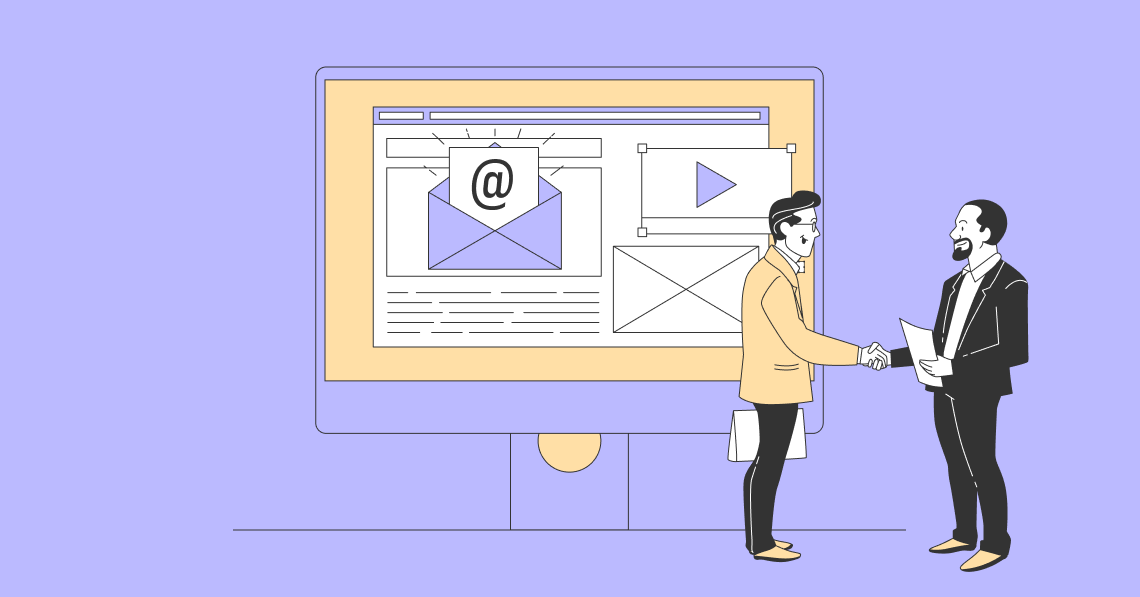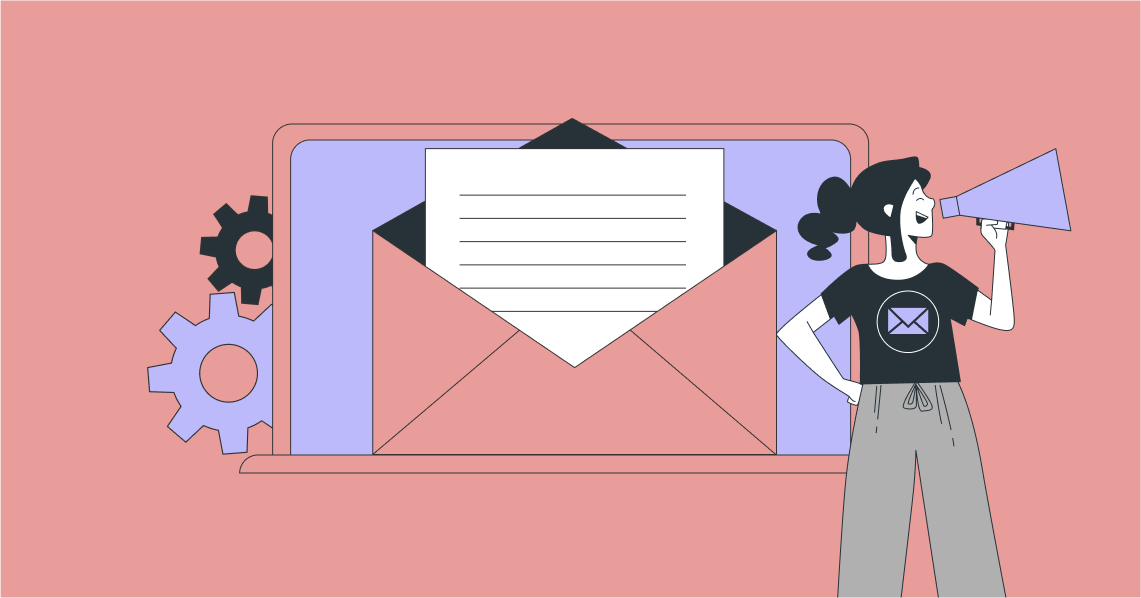It’s that time of the year that you’ve been waiting for – time to take your email marketing to the next level. While holiday sales have increased every year for the past 12 years, according to Statista, there’s also increased competition at this time of the year. This means that you’ll have to think of creative ways not to drown in the sea of other promotions.
Email marketing can be especially effective for holiday marketing. Considering how many gifts consumers must buy at once during this time of the year, they’re eager to make the most of sales. What’s more, with email, they can buy instantly and, this way, skip the queues.
Another reason why marketers can get a better return on investment with holiday email messages is because of personalization. With email, you can create content that your recipients will find more relevant. From including their name to offering gift ideas based on their previous purchases, there are a number of best practices that can help you to increase your sales.
To help you plan and implement a holiday marketing campaign, here are our top tips and favorite strategies. We’ve also included some examples to get you inspired this season.
Holiday Email Marketing: 19 Ideas to Keep You Busy This Season:
- 1. Craft catchy subject lines
- 2. Create a gift guide
- 3. Send an annual update
- 4. Share your traditions
- 5. Hold a holiday preview sale
- 6. Focus on Black Friday and Cyber Monday earlier
- 7. Remember alternative “holidays”
- 8. Create an online advent calendar
- 9. Set up a sale countdown
- 10. Offer free shipping
- 11. Send holiday promo codes
- 12. Promote special gift packages
- 13. Run a competition
- 14. Create a dedicated landing page
- 15. Optimize your footer
- 16. Highlight shipping times and returns
- 17. Create last-minute deals
- 18. Celebrate the new year
- 19. Don’t forget the morning after
- Frequently Asked Questions
19 Holiday Email Marketing Ideas to Try
1. Craft catchy subject lines
Emails are a lot like gifts – both are meant to be opened for it to be of any value. Though, unlike gifts, people are a lot more reluctant to open emails.
When writing email subject lines, you have three strategies to boost open rates: personalization, right wording, and (when words fail you), emojis.
According to Campaign Monitor, an email with a personalized subject line is 26% more likely to be opened. The easiest way to personalize it is simply to include the name of the recipient.
Depending on your brand identity, you can also include emojis in your subject lines. Not only can it make it easier for your subject line to fit the smaller screen of a mobile device, but it can also help your emails to stand out. To make it more relevant for holiday marketing, try to include emojis like a snowman, santa, gift, or Christmas tree.
Here are some subject line examples that other brands have used that you can adapt for your emails:
- Les McKeown: “The DEADLINE is now…”
- United by Blue: “This is Not a Sale. It’s a Celebration.”
- Paperless: “Early bird gets the sale”
- Groupon: “Deals That Make Us Proud (Unlike Our Nephew, Steve)”
- Happy Socks: “How d’ya like your socks in the morning?”
- Blue Apron: “Sure, you *could* send a fruit basket”
2. Create a gift guide
Let’s face it, the holiday season can be stressful. One reason for this contradictory feeling is the search for the perfect gift.
To help your email list, you can create a gift guide based on product type, interests, or age group. In fact, why stop at one? It’s not uncommon for brands to send multiple gift guides in the weeks leading up to Christmas.
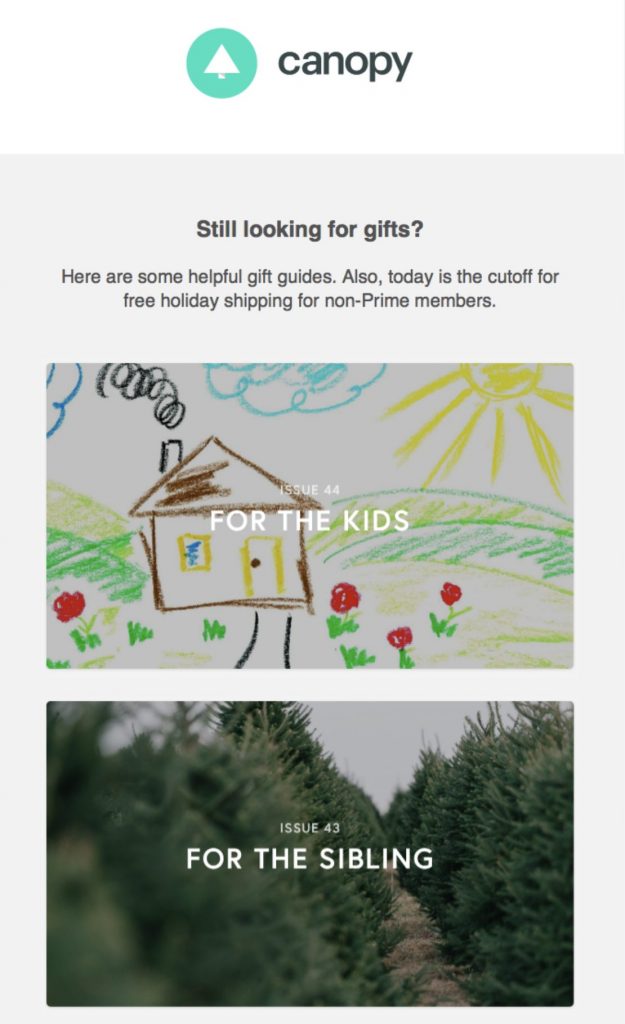
Source: reallygoodemails.com
3. Send an annual update
You can also use the approaching holiday season as an opportunity to summarize the milestones of the past year. Authenticity and transparency are becoming increasingly important to consumers and this type of reflection can help to humanize your brand and strengthen your connection.
You can also use this type of email as a chance to thank your subscribers for their continued support. For example, including a special holiday video can be a great way to do this. Not only will the thank you feel more sincere, but it’s a chance to introduce your team so that your subscribers can put a face behind the names.
4. Share your traditions
Another way that you can humanize your brand and make a more personal connection with your target audience is by sharing some of your traditions. Does your family do something special for each Thanksgiving? How do others in your team celebrate the holidays with their families?
5. Hold a holiday preview sale
Some consumers (aka the clever ones) prefer to skip the holiday rush. While it might not be many, it can be a good idea to hold a preview sale. Not only can this strategy help you to get a few early sales, but you can also use it as a chance to grow your email subscriber list by sharing that you’ll be sending more (and bigger) holiday offers via email in the weeks leading up to the event.
6. Focus on Black Friday and Cyber Monday earlier

Source: reallygoodemails.com
According to data shared by Adobe Analytics, consumers spent more than $10 billion on Cyber Monday in 2020, making it the biggest shopping day in the history of eCommerce in the United States. It’s not just the generous discounts that drive the sales on this day, but also the fact that consumers had time to plan and save for this special event on the calendar.
Data from Criteo shows that retail traffic has already increased by almost 50% 10 days before Black Friday. What’s more, customers who supported a store for the first time on Black Friday, visited the store’s website on average 41 days before the event already.
The takeaway – don’t leave your marketing for a week before big sales events. Even if it’s only to get your email list to start thinking about Black Friday and Cyber Monday, start promoting early.
7. Remember alternative “holidays”
While it’s important to focus on big shopping events on the calendar, such as Cyber Monday and Black Friday, early, you shouldn’t forget about alternative events. You can, for example, also look at GivingTuesday. In the US, GivingTuesday (aka #GivingTuesday) is the Tuesday after Thanksgiving. The aim of this day is to get individuals and companies to change their communities and the world by doing good.
By creating emails for less mainstream days like this too, you can also appeal to consumers who value social sustainability. As a brand, you can, for example, announce that you’ll donate a percentage of your sales to a cause that’s important to your target audience.
Or you can take this leaf out of Lyft’s book. They chose to round up the total to the nearest dollar and donate the difference to help support hunger relief.
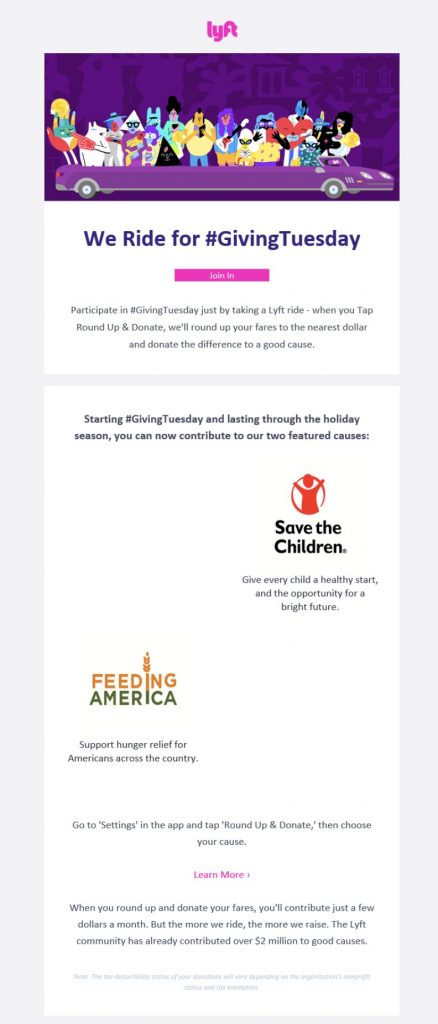
Source: reallygoodemails.com
8. Create an online advent calendar
An online advent calendar can help you to boost brand interest and engagement for longer and help you to take complete advantage of this season that comes only once a year. With this approach, you’ll send your subscribers daily emails. When they click on the day’s date, you can, for instance, share product tips, inspirational quotes, funny video clips, contests, gift ideas, and the occasional discount. Think of it as an advent calendar for adults. Instead of chocolate treats, you’ll be sharing food for the soul and fuel for the brain.
9. Set up a sale countdown
Advent calendars can work well for counting down the days till Christmas, but what about the other major events on the holiday calendar? To help create a sense of urgency around other sales that you might be running, you can include a digital timer that tracks how many days subscribers have left to take advantage of your offer.
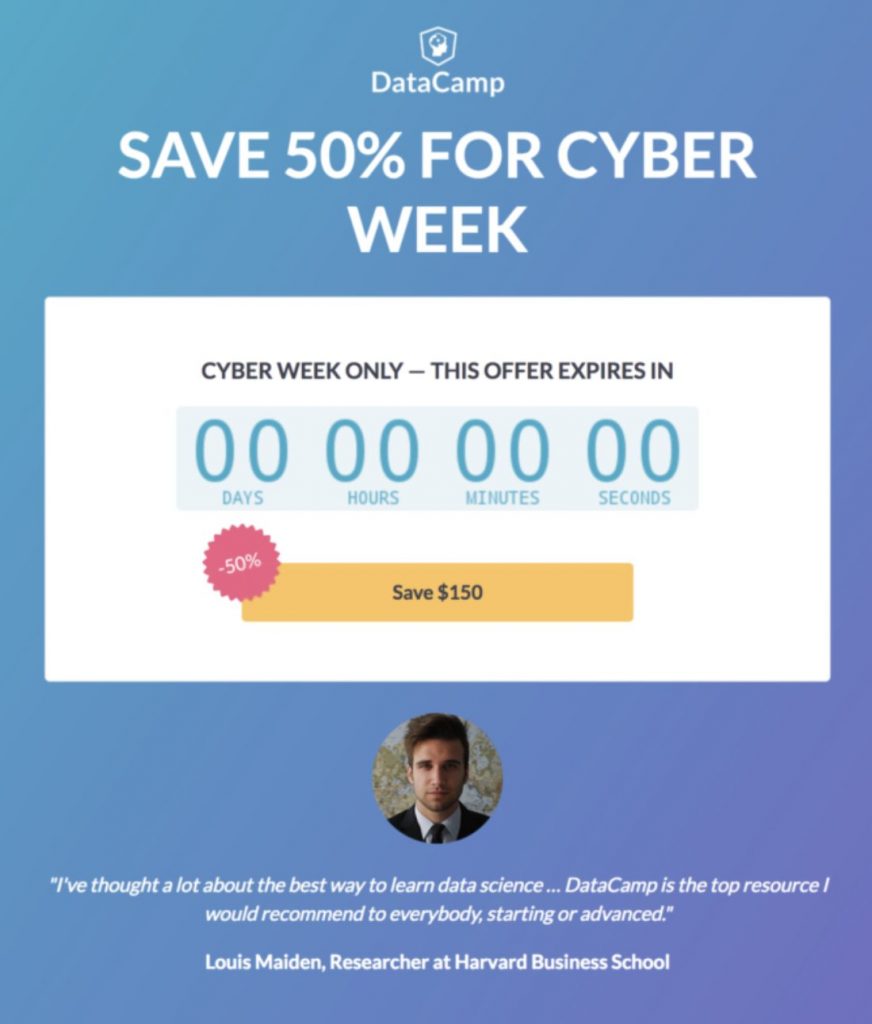
Source: reallygoodemails.com
10. Offer free shipping
Free shipping is a firm favorite. It might come as a surprise, but, according to RetailMeNot, 82% of Americans actually prefer free shipping over expedited shipping.
One of the advantages of using free shipping as an incentive is that you don’t have to include it for the whole duration of your sale or for everything. Instead, you can, for example, offer it only to orders that add up to a certain amount (a great way to increase the average order value too), or limit it to specific products or days.
For example, Elysium decided to offer free one-day shipping to last-minute shoppers. This way last-minute shoppers could rest assured knowing that they won’t be punished for their procrastination this year.
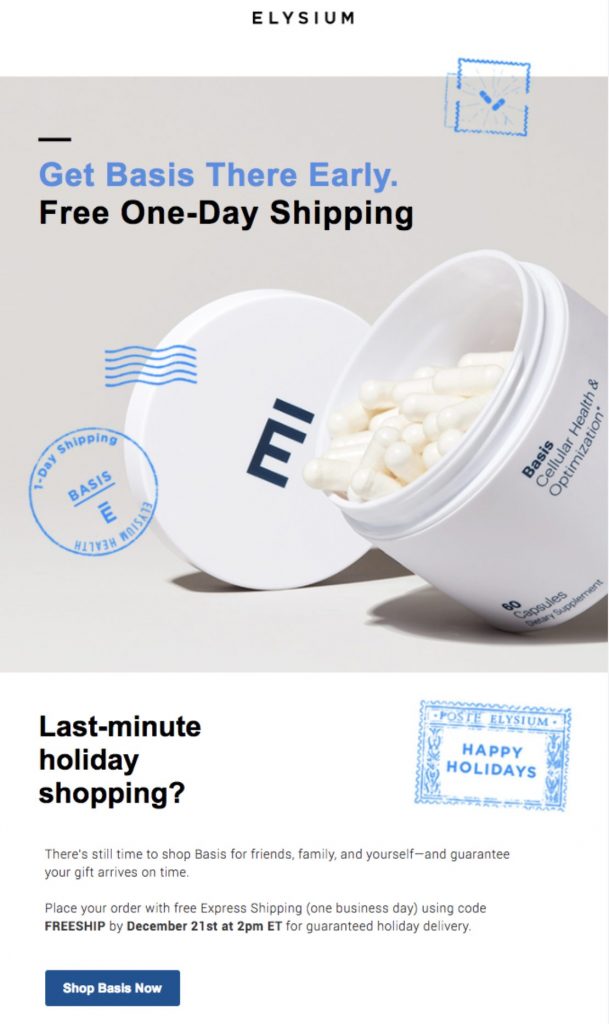
Source: reallygoodemails.com
11. Send holiday promo codes
You can use promo codes in different ways during the weeks leading up to the holiday season. It can either be the sole focus of a specific email or used as an add-on to your monthly email newsletter. Whichever approach you prefer, it can be a good incentive for potential customers to support your store this year.
Plus, promo codes also offer more advantages than the conventional cut-out-and-keep coupons. By emailing a coupon code, you can limit the discount to a number of customers. It also makes it much easier to track the progress of your email campaigns.
12. Promote special gift packages
Another way that you can add more value for your target audience without offering a discount that cuts into your profit margin is to create special gift packages. Basically, you’ll be doing the cross-selling for them by combining items to create a unique gift package. Not only is this type of gift more special, but it’s also a great way to set yourself apart from the competition.
Alternatively, you can keep it simple and just offer to change the packaging of the product if it’s a gift. Knowing that your products come wrapped can be the only incentive potential customers might need to support you instead of your competitors. Plus, if you use branded wrapping paper, it’s a great way to boost brand awareness too.
13. Run a competition
Holiday-themed online contests, such as a photo contest, can be a great way to get new user-generated content that you can use for next year’s marketing. It can also help you to boost website traffic, get more email subscribers, and grow your social media following. If it’s easy to enter and the prize appeals to your target audience, this marketing strategy can be a winner.
14. Create a dedicated landing page
Instead of redirecting the traffic that an email generates to the home page of your website, you can use a landing page that you’ve created specifically for this holiday campaign. This way, potential customers don’t have to search for the sale or product that you marketed on your site.
If you want to increase conversions, it’s all about offering a seamless user experience and landing pages can help to do just that by eliminating distractions. To ensure that your landing page converts, remember to include all the important elements like a unique selling proposition, captivating copy, social proof, and clear calls to action.
If this sounds like too much work, it doesn’t have to be. There are several landing page builder options that you can use (and many of them are also free). In fact, if you’re using an email marketing tool like Sendinblue or GetResponse, a landing page builder is included in the service.
15. Optimize your footer
The email footer is that final block of content in your email template. Brands often place the same old, boring information in the footer area such as the contact information, logo, website link, etc. Though, when it comes to holiday marketing, you can instead use this space to promote gift-related services like gift wrapping, express shipping, or links to gifts under $50. Just remember to keep it simple and include enough white space between the footer sections.
16. Highlight shipping times and returns
It’s different to shop online for yourself than what it is to shop for someone else. For starters, you know that the item is what you want and the likelihood that you’ll want to return the item is slim. Though, what if the person for whom you’re buying it doesn’t like the gift or has received duplicates? Would it be easy to exchange or return?
Secondly, when you’re shopping online for gifts, there’s a definite deadline. So, a shipping time of 7-14 days isn’t going to work.
To address these two issues, consider sending an email that specifically mentions how your returns policy work and another one that highlights your shipping times. You can, for example, send an email as a “last call” for orders that should be delivered before Christmas Day.
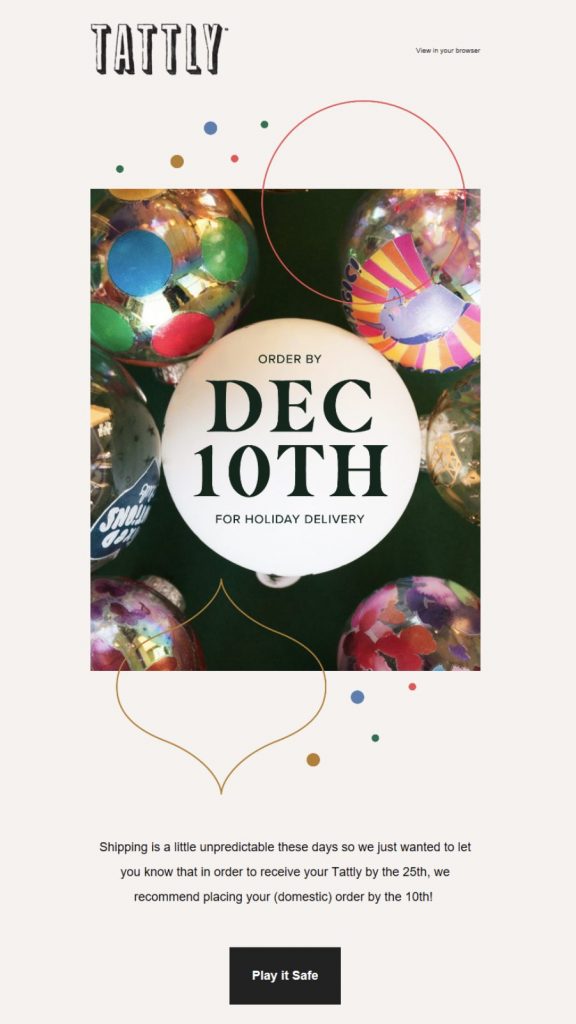
Source: reallygoodemails.com
17. Create last-minute deals
A survey completed in 2020 by Klarna, a payment provider and shopping service, revealed that 79% of shoppers planned to wrap up buying their holiday gifts within two weeks before Christmas. What’s more, 55% of these last-minute shoppers indicated that they were planning on buying these gifts online, even if it meant that it wouldn’t be delivered on time.
So, brands have till the very last minute to continue sending holiday emails. How about specifically marketing electronic gift cards in that last-minute email? This way, your target audience can “leave” their shopping till the last minute and still get the gift on time.
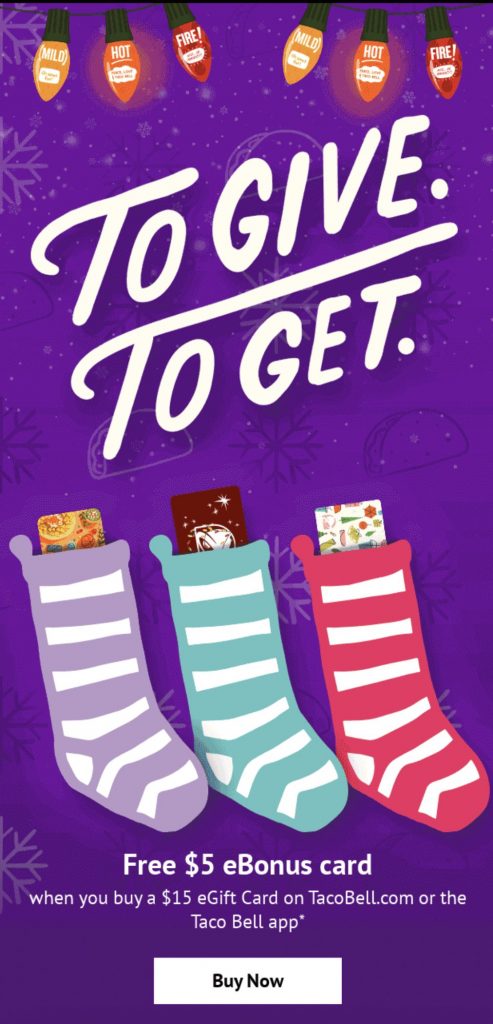
Source: reallygoodemails.com
18. Celebrate the new year
Christmas is often the last event that email marketers focus on when sending holiday marketing emails. Though, New Year’s Day is another event on the calendar that can form part of your campaign this season. Just like you’ve done for Christmas, you can also create a gift guide with ideas for the new year. From home office supplies to a new wardrobe to fitness gear, many people embrace the phrase “out with the old, in with the new” quite literally this time of the year.
If you’ve been very generous throughout the season with promo codes and don’t want to run another sale, you can simply send a branded calendar or planner to help them stay organized in the new year. Printables like these can also be used as lead magnets to help grow your email subscriber list.
19. Don’t forget the morning after
And after all the festivities are done, you’re not quite done with your email marketing strategy just yet. It’s also a good idea to send an email after the last shopping event. For the subscribers who’ve been on your list for a long time, this email can communicate that they can expect to receive fewer emails from you again. For those who’ve recently joined your list, this type of email can help to nurture them into long-term, repeat customers. After all, getting repeat customers should be another goal of any holiday email marketing strategy too.
Wrapping Things Up
The last few months of the year are a busy period as people race against the clock to get everything ticked off their to-do lists. Plus, considering that for the holiday period, people typically have to buy for multiple people at once, shopping for the ideal gifts can quickly become even more daunting.
So, when you’re planning your email marketing campaign ideas, focus on how you can make it easier for your target audience. From preview sales to personalized gift guides to shipping times reminders, there are many ways that you can use email to reach your audience and offer valuable content. Not every email that you send has to be about a sale.
After all, the holiday season is all about connection. By getting more personal, your holiday emails can also boost brand loyalty which will serve you well in the new year.
Frequently Asked Questions
What are the benefits of holiday email marketing?
Email marketing consistently delivers a better ROI than other marketing channels. For every $1 you spend on it, you have the potential to earn over $40 in return. Email marketing can be especially effective for holiday marketing. Consumers must buy multiple gifts at once during this time of the year and so they’re eager to make the most of sales. Plus, with email, they can buy instantly and skip the queues. Not only can it help you to increase sales, but also to boost loyalty.
Are there email marketing tools that you can use for free?
Yes! As a matter of fact, there are several great email marketing tools that you can use for free. These include:
- Sendinblue
- Omnisend
- ConvertKit
- EmailOctopus
- Mailchimp
- MailerLite
- AWeber
All these tools have some type of free plan, but limit the number of contacts you can add or emails that you may send. For example, with ConvertKit’s Free plan you can manage up to 1,000 subscribers, while EmailOctopus lets you add up to 2,500 subscribers and allows you to send 10,000 emails per month.
What’s email personalization?
In short, email personalization is when you send individualized content to your subscriber list based on data about their demographics, age, previous purchases, etc. For email personalization to work, you need to segment your email list and make sure that whatever content you send is relevant and will meet their requirements. All things considered, it’s a great way to create a sense of exclusivity so that each and every subscriber feels valued which helps to improve the user experience.
What’s email personalization?
In short, email personalization is when you send individualized content to your subscriber list based on data about their demographics, age, previous purchases, etc. For email personalization to work, you need to segment your email list and make sure that whatever content you send is relevant and will meet their requirements. All things considered, it’s a great way to create a sense of exclusivity so that each and every subscriber feels valued which helps to improve the user experience.
What are the benefits of using promo codes in your holiday email marketing?
Promo codes can be a win-win situation. They can offer your customers more incentive to shop from your store this holiday season which means that you will make more money. Not only will it help you to set yourself apart from the competition during a very competitive time, but your customers will also feel as if they’ve won. What’s more, you have the option to limit the number of customers who may participate in a promotion or share it with only specific people like first-time buyers.
What are some tips for creating a landing page?
Good eCommerce landing pages focus on what visitors will gain instead of focusing on the brand itself. It also uses high-quality photos, ample white space, clear call-to-action buttons and social proof, such as testimonials. Headings are generally short, while subheadings can be used to elaborate on the headline by describing the value proposition in more detail. Landing pages that advertise products that are visually pleasing and self-explanatory typically rely more on high-quality photos than big chunks of text.
